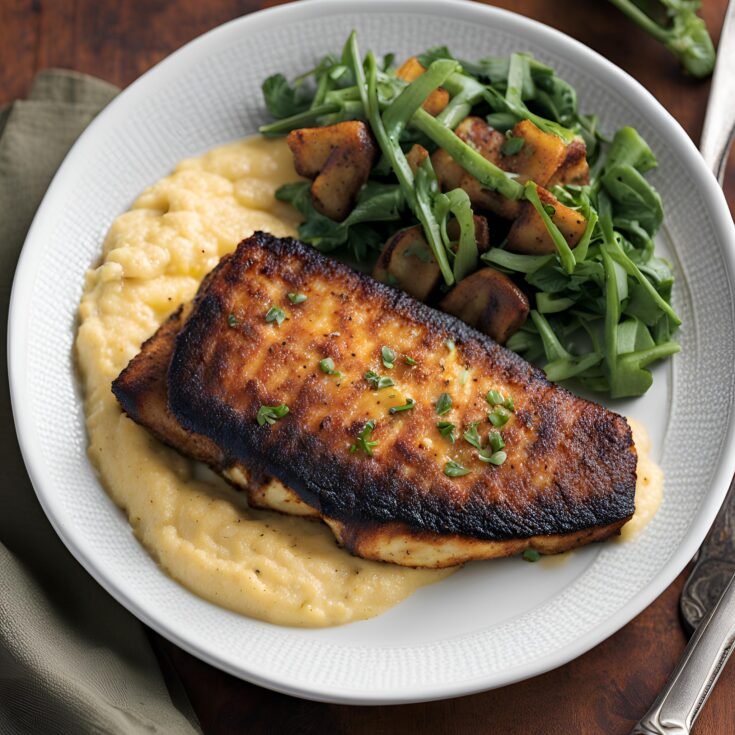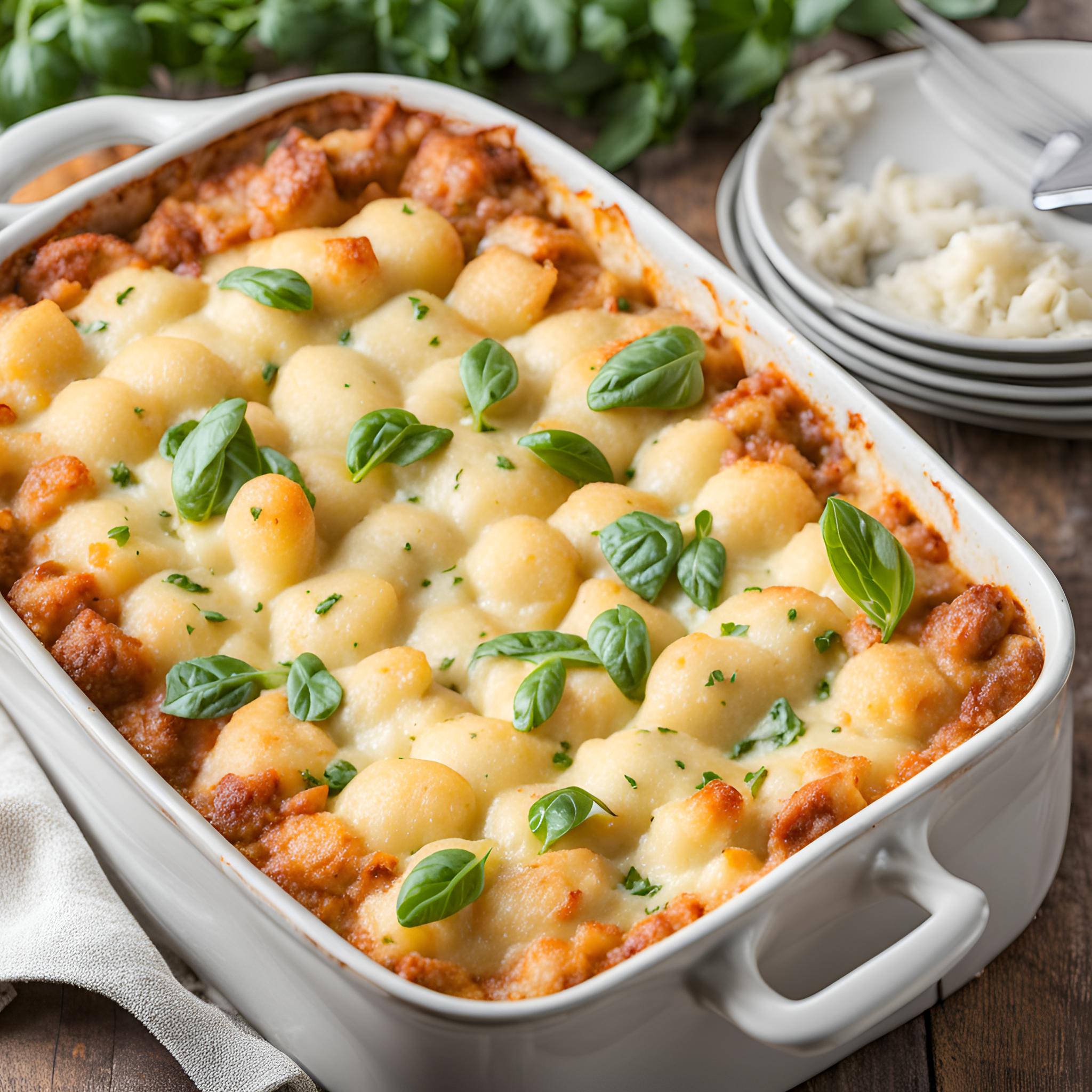Blackened Fish and Cheese Grits
Introduction
There’s something magical about Southern cuisine. It’s hearty, comforting, and often steeped in tradition. One dish that perfectly encapsulates this is blackened fish and cheese grits. It’s a combination that offers a delightful contrast of flavors and textures, with the spicy, crispy fish playing off the creamy, cheesy grits. But why has this dish become a staple in Southern kitchens? Let’s dive into the rich history, preparation, and cultural significance of blackened fish and cheese grits.

What is Blackened Fish?
The Origins of Blackened Fish
Blackened fish is a cooking method that became popular in the 1980s, thanks to Chef Paul Prudhomme, who introduced it to the masses through his New Orleans restaurant. The technique involves coating fish in a blend of spices and then cooking it in a hot skillet, typically cast iron, until it develops a dark, crispy crust. The result is a dish that’s bursting with flavor, with the spices caramelizing to create a unique, smoky taste.
The Science Behind the Blackening Technique
The blackening process is all about high heat. When the fish is placed in the hot skillet, the butter or oil used in the preparation helps the spices adhere and caramelize. The Maillard reaction, a chemical reaction between amino acids and reducing sugars, occurs, resulting in that beautiful, blackened crust. It’s this reaction that gives the fish its deep, rich flavor.
Common Fish Types for Blackening
While you can technically blacken any type of fish, certain varieties work better than others. Redfish, catfish, snapper, and grouper are among the most popular choices due to their firm texture and ability to hold up well to high heat.
The Magic of Cheese Grits
A Brief History of Grits
Grits have been a staple in Southern cuisine for centuries, originating from Native American communities who ground corn into a coarse meal. This dish has evolved over time, becoming a beloved comfort food that’s versatile enough to be served at breakfast, lunch, or dinner.
The Role of Cheese in Elevating Grits
Adding cheese to grits takes them from a simple side dish to a star in its own right. The cheese adds a rich, creamy texture and a savory depth of flavor that pairs perfectly with the spicy blackened fish. While cheddar is the most common choice, you can experiment with other varieties like gouda, parmesan, or even a spicy pepper jack for an extra kick.
Different Cheese Options for Grits
The beauty of cheese grits lies in their versatility. You can opt for sharp cheddar for a classic taste, or go for a smoked gouda if you’re looking to add a hint of smokiness. For those who like a bit of heat, pepper jack is a great option, offering a spicy twist to the creamy grits.
Choosing the Perfect Fish
Best Types of Fish for Blackening
As mentioned earlier, redfish, catfish, snapper, and grouper are top choices for blackening. These fish have a firm texture that holds up well to the intense heat of the skillet, ensuring that the flesh remains tender and flaky while the exterior develops a crisp, flavorful crust.
Fresh vs. Frozen: What Works Best?
When it comes to blackening fish, fresh is always best. Fresh fish will have a better texture and flavor, which is crucial when you’re relying on the natural taste of the fish to shine through the spices. However, if fresh fish isn’t available, frozen can work in a pinch—just be sure to thaw it properly and pat it dry before cooking to avoid excess moisture, which can prevent proper blackening.
Sustainable Seafood Choices
Choosing sustainable seafood is not only better for the environment but also ensures that you’re getting a quality product. Look for fish that’s certified by organizations like the Marine Stewardship Council (MSC) or the Aquaculture Stewardship Council (ASC) to ensure that your seafood is sustainably sourced.
Ingredients Needed
Essential Ingredients for Blackened Fish
To make the perfect blackened fish, you’ll need the following ingredients:
- Fresh fish fillets (redfish, catfish, snapper, or grouper)
- Unsalted butter
- A blend of spices, including paprika, cayenne pepper, garlic powder, onion powder, thyme, oregano, salt, and black pepper
- Lemon wedges (for serving)
Key Ingredients for Cheese Grits
For the cheese grits, you’ll need:
- Stone-ground grits
- Water or chicken broth
- Milk or heavy cream
- Sharp cheddar cheese (or your choice of cheese)
- Salt and pepper to taste
- Butter
Optional Add-ons and Sides
Consider serving your blackened fish and cheese grits with a side of sautéed greens, roasted vegetables, or a simple salad. You can also add a drizzle of hot sauce or a sprinkle of fresh herbs like parsley or chives for an extra burst of flavor.
Step-by-Step Guide to Blackening Fish
Preparing the Fish Fillets
Start by patting your fish fillets dry with a paper towel. This step is crucial for achieving that perfect blackened crust. Next, melt some butter and brush it over the fish, ensuring that each fillet is evenly coated.
Creating the Perfect Blackening Seasoning
In a small bowl, combine the spices: paprika, cayenne pepper, garlic powder, onion powder, thyme, oregano, salt, and black pepper. Mix well, then generously coat each fish fillet with the seasoning mix, pressing it into the fish to ensure it adheres well.
Cooking the Fish to Perfection
Heat a cast-iron skillet over high heat until it’s smoking hot. Add a little butter or oil to the pan, then carefully place the seasoned fish fillets into the skillet. Cook for about 2-3 minutes on each side, or until the fish is cooked through and the exterior is deeply browned and crispy. Serve immediately with lemon wedges.
Making the Creamiest Cheese Grits
Selecting the Right Grits
For the creamiest cheese grits, opt for stone-ground grits. They have a coarser texture than instant grits and offer a more robust flavor.
Cooking Grits to the Ideal Consistency
Begin by bringing water or chicken broth to a boil in a pot. Slowly whisk in the grits, then reduce the heat to low. Cook the grits, stirring occasionally, until they reach your desired consistency—this usually takes about 20-25 minutes. Add more liquid if necessary to keep the grits creamy.
Incorporating Cheese for Maximum Flavor
Once the grits are cooked, stir in the butter and cheese until fully melted and incorporated. Season with salt and pepper to taste, and serve immediately alongside the blackened fish.
Pairing the Dish
The Best Sides for Blackened Fish and Cheese Grits
Some great sides to pair with blackened fish and cheese grits include sautéed greens, roasted Brussels sprouts, or a fresh garden salad. These sides offer a balance to the rich and creamy grits and the spicy, flavorful fish.
Beverage Pairings: What Complements the Dish?
For beverages, consider a crisp white wine like Sauvignon Blanc or Chardonnay. If you prefer beer, a light lager or pilsner would complement the bold flavors of the dish without overpowering it.
Tips for Perfecting Your Recipe
Common Mistakes to Avoid
One common mistake is not drying the fish fillets thoroughly before seasoning and cooking. Excess moisture can prevent the fish from developing that signature blackened crust. Another mistake is overcrowding the pan, which can cause the fish to steam rather than sear.
Pro Tips for Extra Flavor
For an extra burst of flavor, try adding a bit of smoked paprika to the seasoning mix. You can also top the fish with a squeeze of fresh lemon juice right before serving to brighten up the dish.
How to Store and Reheat Leftovers
If you have leftovers, store the fish and grits separately in airtight containers in the refrigerator. To reheat, warm the fish in a skillet over medium heat, and reheat the grits in a pot with a splash of water or milk to restore their creamy consistency.
Health Considerations
Nutritional Value of Blackened Fish
Blackened fish is a healthy option, as it’s typically cooked with minimal fat and is high in protein and omega-3 fatty acids. The spices used in blackening also offer anti-inflammatory benefits.
The Caloric Content of Cheese Grits
Cheese grits are more indulgent, as they are rich in calories due to the cheese and butter. However, they are also a good source of calcium and can be enjoyed in moderation as part of a balanced diet.
Making a Healthier Version of the Dish
To make a healthier version of this dish, consider using a lighter cheese or reducing the amount of butter in the grits. You can also opt for grilled fish instead of blackened to cut down on the fat content.
Cultural Significance
Blackened Fish in Southern Cuisine
Blackened fish is a quintessential dish in Southern cuisine, particularly in Louisiana, where it’s often associated with Cajun and Creole cooking. It’s a dish that embodies the bold, vibrant flavors that Southern food is known for.
The Importance of Grits in Southern Culture
Grits are more than just a side dish in the South—they’re a symbol of comfort and tradition. Whether served at breakfast or as part of a dinner entrée, grits hold a special place in Southern hearts and kitchens.
How This Dish Brings People Together
Blackened fish and cheese grits is the kind of dish that brings people together. Whether you’re serving it at a family dinner or a casual gathering with friends, it’s a meal that’s sure to impress and satisfy.
Frequently Asked Questions (FAQs)
Can I Use a Different Type of Fish?
Yes, you can use any firm white fish for blackening, such as tilapia, cod, or haddock. Just be sure to adjust the cooking time based on the thickness of the fillets.
How Do I Make Cheese Grits Creamier?
To make cheese grits creamier, use a combination of milk and heavy cream instead of just water or broth. Adding a bit more butter and cheese can also enhance the creaminess.
What Are Some Good Sides for This Dish?
Good sides include sautéed greens like collard or kale, roasted vegetables, or a fresh salad. These sides help balance the richness of the grits and fish.
Can I Make This Dish in Advance?
While blackened fish is best served fresh, you can make the cheese grits ahead of time and reheat them before serving. Just add a splash of water or milk to restore their creamy texture.
Is This Dish Kid-Friendly?
Yes, this dish can be kid-friendly, especially if you reduce the amount of cayenne pepper in the seasoning. You can also serve the fish with a mild sauce to tone down the spice for younger palates.
Conclusion
Blackened fish and cheese grits is a dish that truly captures the essence of Southern comfort food. The bold flavors, contrasting textures, and rich cultural significance make it a meal that’s both satisfying and memorable. Whether you’re a seasoned cook or a kitchen novice, this recipe is sure to become a favorite in your culinary repertoire. So why not give it a try today? You’ll be glad you did.
Blackened Fish and Cheese Grits

There's something magical about Southern cuisine. It's hearty, comforting, and often steeped in tradition. One dish that perfectly encapsulates this is blackened fish and cheese grits. It's a combination that offers a delightful contrast of flavors and textures, with the spicy, crispy fish playing off the creamy, cheesy grits. But why has this dish become a staple in Southern kitchens? Let's dive into the rich history, preparation, and cultural significance of blackened fish and cheese grits.
Ingredients
- Cheese Grits:
- 3 ½ cups low-sodium chicken broth
- 1 cup half and half - or milk or heavy cream
- 1 teaspoon salt
- 1 teaspoon onion powder
- 1 teaspoon garlic powder
- ½ teaspoon black pepper
- ¼ teaspoon cayenne pepper
- 1 cup stone ground grits - see note
- 1 cup smoked gouda cheese - freshly shredded
- 2 tablespoons unsalted butter
- Blackened Fish:
- 4 catfish filets - about 1.5 pounds, rinsed and patted dry
- 2 tablespoons melted butter - unsalted
- 2 tablespoons homemade blackened seasoning - or store-bought
- 1 tablespoon extra-virgin olive oil
- Cajun Cream Sauce:
- 2 tablespoons unsalted butter
- ½ cup yellow onion - chopped
- ½ cup red bell pepper - seeded and chopped
- 2 cloves garlic - minced
- ½ cup chicken broth
- ½ cup heavy cream
Instructions
Add the chicken broth, half and half, salt, onion powder, garlic powder, black pepper, and cayenne pepper to a medium saucepan and bring the mixture to a boil over medium-high heat. Slowly pour the grits into the pan while stirring with a wooden spoon so lumps do not form.
Lower the heat to medium, cover the pot, and simmer the grits for 35-45 minutes, or until tender and creamy, stirring occasionally.
Meanwhile, rinse and pat the catfish fillets dry. Brush both sides of each piece of fish with melted butter and coat each side with blackened seasoning, rubbing it into the fish with your hands.
Heat 1 tablespoon of extra-virgin olive oil over medium-high heat in a 10-inch cast-iron skillet. Place the catfish in the heated skillet and cook for 3-5 minutes per side until a charred crust forms on the outside and it is cooked through. Transfer the fish to a paper towel-lined plate.
In the same skillet that you cooked the fish in, melt two tablespoons of butter over medium-high heat. Add the chopped onion and bell pepper and cook for 2 to 3 until the onion is translucent. Add the garlic and cook for another minute, stirring constantly with a wooden spoon.
Pour the chicken broth and heavy cream into the skillet and season with blackened seasoning. Cook the sauce for 4 to 6 minutes until it thickens and coats the back of a spoon. Remove the pan from the heat.
Notes
- If you use quick-cooking grits the measurements and cooking time in this recipe will not work. Please follow the instructions on the package if using quick-cooking or instant grits.
- This recipe can be made with many other types of fish, including cod, snapper, tilapia, salmon, or trout. Be sure to adjust the cooking times as needed.
- Leftover blackened fish and grits can be stored separately in airtight containers in the refrigerator for up to three days.
Nutrition Information:
Amount Per Serving: Calories: 600



